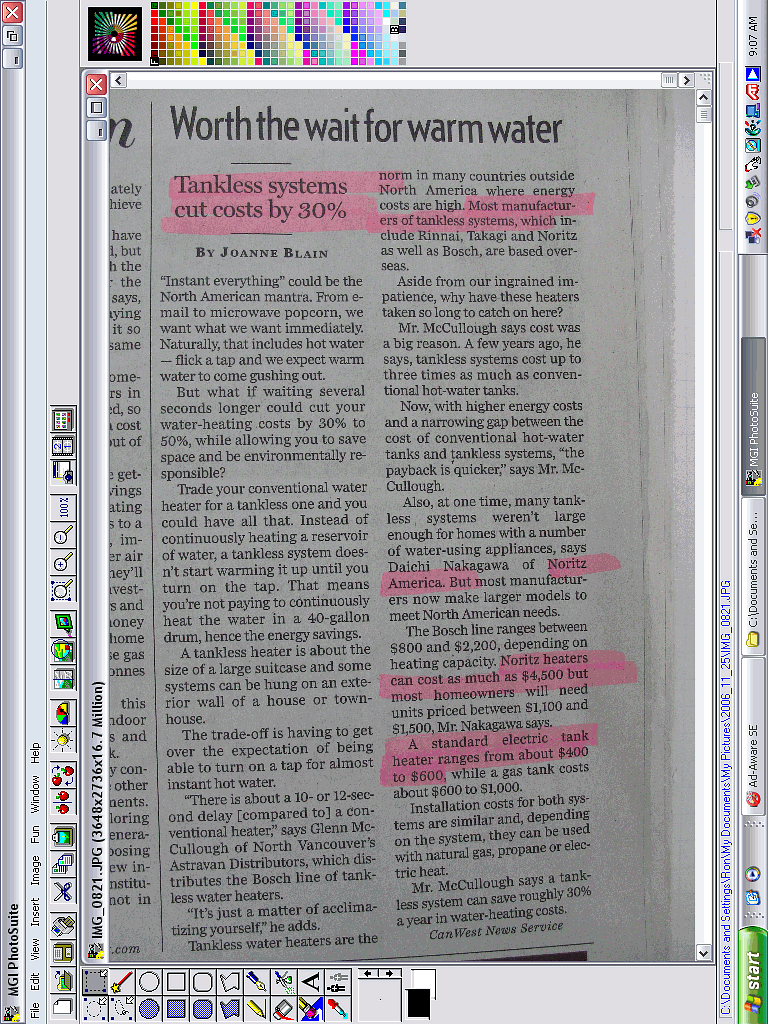Energy Saving Idea
Here is a realistic, simple, energy saving idea that will significantly reduce electricity consumption, save you money and help the environment. The city of Toronto is just now in 2006 starting to implement inline hot water heaters.
The Ontario Power Authority (OPA), a provincial Crown Corporation still doesn’t get it. Over the years since the first energy crunch in the early 70s, Billions of dollars in debt have accumulated due to power mismanagement and as a result Ontario consumers are servicing that debt!!!
A recently released report, by the OPA, states that 33% of Ontarios electricity consumption is due to “electric home water heaters”, according to a Toronto Star article by Peter Gorrie, Feb 4 2006. As a homeowner and a professional graduate engineer I knew of this fact as early as 1980 when I installed a second kilowatt hour meter on our home hot water tank. What took OPA so long to figure this out? You would have thought that someone would have thought of inline electric water heaters, a long time ago. Inline electrical water heaters are an obvious solution to reduce electricity consumption. Inline electrical water heaters, raise the water temperature to the usage temperature as its being used and thus save energy as follows.
No standby loss.
No dilution loss.
No exhaust loss (as in natural gas water heaters).
It does not make sense to retain 60 gallons of water (600 pounds) sitting at 150 F twenty four hours a day losing energy to a 50 F concrete floor (standby losses) waiting to be used for a 5 minute shower possibly once a day. We then use the water to shower, add cold water to bring the temperature down to a comfortable 100F (dilution losses). Electrical inline water heaters make sense over natural gas inline water heaters because electrical inline water heaters in comparison are 100% efficient. All of the energy ends up in the water with no exhaust gas loss because the electrical heating coil is surrounded by water as it passes by the heating coil. Insulating hot water lines and wrapping your hot water tank with insulation to minimize energy loss is insignificant and foolish because what little heat that is lost is captured in the house anyhow.
There are two issues that need to be addressed by Provincial and Federal governments. If one showers at a rate of one or two gallons per minute the instantaneous electrical demands can be as much as 100 amps and in worse case scenarios in the winter months two of these units may be required. Obviously the power grid must be upgraded first in order to meet instantaneous demands! The inline electrical water heating units are currently expensive and most home owners find it difficult to justify the additional purchase and installation expenses even though energy savings and the payback are realistic. For this energy saving idea to happen (its been used in Europe for years) we need some leadership from OPA and the provincial and federal governments.
All new homes constructed in Canada should have as an absolute minimum, a 300 amp electrical service, therefore allowing for up to 200A for inline water heating when the power grid is capable of handling these new demands. A 300 amp service is insignificant in the total cost of a home today. Secondly, tax breaks should be given to homeowners that install these new and/or retrofit inline electrical water heaters. Finally, in the long term, the OPA with all of its resources should look into a made in Canada solution and appoint a Canadian manufacturer (tendered of course) the rights to produce these units in Canada.
Installing smart electrical meters in homes to charge Ontario consumers more for electricity at peak demand times is a small step in the right direction but the smart meters will only (hopefully) minimize peak demands on the grid, not save energy. People still have to shower, take baths, wash clothes now they will just do it at staggered times.
Ron Cirotto, BASc., P.Eng
Burlington, Ontario

